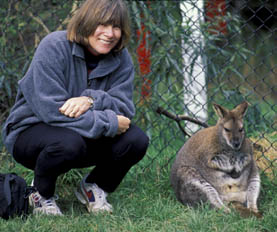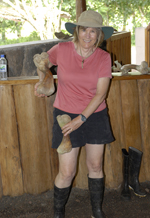Kathleen K. Smith

Professor, Department of Biology,
Email Kathleen
Box 90338, Duke University, Durham, NC 27708
122 Biological Sciences Building
919 684-3402 (office phone)
1973 BA, University of California, Santa Cruz
1980 PhD, Harvard University
1980, Assistant Professor of Anatomy, Duke University
1988, Associate Professor of Biological Anthropology and Anatomy
2000, Associate Professor of Zoology
1997, Professor of Biological Anthropology and Anatomy
1994-1995, Vice Provost for Academic Affairs
2000, Professor of Biology
2000-2002, Chair, Department of Biology
1998-2008, Faculty Athletics Representative, Duke University
2006-2010, Director of the National Evolutionary Synthesis Center (NESCent)
 I have studied a wide variety of projects on cranial development, function and evolution in vertebrates. In recent years I have focused on comparative studies of craniofacial development in marsupial and placental mammals. This work has demonstrated that one of the most fundamental differences between the two clades is a delay in marsupials of the development of the central nervous system (CNS) and cranial sense organs and an advancement of certain cranial skeletal-muscular tissues. Specifically, in marsupials the central nervous system and particularly the forebrain is delayed relative to the development of the bones around the oral apparatus, the chondrocranium and the differentiation of cranial muscles. Functionally these heterochronies are likely to relate to the need for the highly altricial neonate to function independently.
I have studied a wide variety of projects on cranial development, function and evolution in vertebrates. In recent years I have focused on comparative studies of craniofacial development in marsupial and placental mammals. This work has demonstrated that one of the most fundamental differences between the two clades is a delay in marsupials of the development of the central nervous system (CNS) and cranial sense organs and an advancement of certain cranial skeletal-muscular tissues. Specifically, in marsupials the central nervous system and particularly the forebrain is delayed relative to the development of the bones around the oral apparatus, the chondrocranium and the differentiation of cranial muscles. Functionally these heterochronies are likely to relate to the need for the highly altricial neonate to function independently.
This observation is also important because in many fundamental ways the central nervous system is responsible for patterning the skeletal tissues of the head. In particular the CNS, through the differentiation of the neural crest, provides the material for the cranial skeleton, and the CNS provides signals thought to be important in the induction and patterning of the chondrocranium.
We have examined the differentiation and migration of the cranial neural crest and have shown that relative to the differentiation of the paraxial mesoderm, or the neural tube, neural crest differentiation is accelerated in marsupials relative to all other amniotes thus far described. Therefore, the heterochrony between neural and somatic tissues observed in organogenic stages begins at the very earliest differentiation of these tissues. It is particularly interesting that the neural crest migrates before there is any significant subdivision of the neural plate.
In addition the lab has examined the development and differentiation of the somites and limb buds, the development of the heart in marsupials, and the differentiation of major features of the brain in Monodelphis. I am also continuing my work on approaches to heterochrony; a historical study of JP Hill and his work on neural crest in marsupials, and comparative work on development and reproduction in different mammalian clades with an aim to understanding the origins of mammalian developmental and reproductive patterns.
Click here to link to papers from the Smith lab top of page
Fun - all work and no play makes for dull company! 
